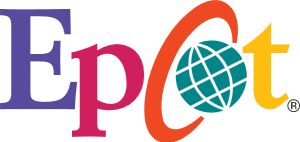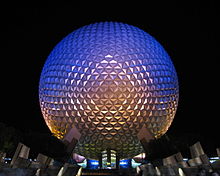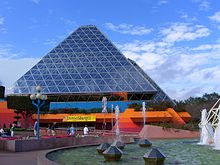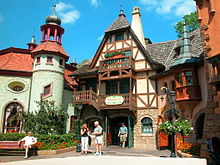
Epcot, Walt Disney World, Orlando, Florida
Epcot Theme Park and Tourist Attraction in FloridaEPCOT, Orlando, Florida
Epcot is the second of four theme parks built at Walt Disney World in Bay Lake, Florida, near the city of Orlando. It opened as EPCOT Center on October 1, 1982, and spans 300 acres (120 ha), more than twice the size of the Magic Kingdom park. It is dedicated to the celebration of human achievement, namely technological innovation and international culture, and is often referred to as a “permanent World’s Fair.” In 2014, the park hosted approximately 11.45 million guests, ranking it the third most visited theme park in North America and the sixth most visited theme park in the world. The park is represented by Spaceship Earth, a geodesic sphere that also serves as an attraction. Epcot was known as EPCOT Center until 1994, when it was later renamed Epcot ’94, then Epcot ’95 the following year.

Spaceship Earth
Spaceship Earth at Night in EPCOT, Walt Disney World

Epcot Imagination
Glass Pyramids at Epcot Imagination

Epcot Germany Pavilion
Germany Pavilion at Epcot World Showcase
Epcot, Orlando, Florida
Epcot, Walt Disney World, Orlando, Florida
Epcot, 200 Epcot Center Dr, Orlando, FL 32821, USA
Zoom In Map To See More Detail
History
The park’s name, EPCOT, is an acronym for Experimental Prototype Community of Tomorrow, a utopian city of the future planned by Walt Disney, often interchanging “city” and “community.” In Walt Disney’s words: “EPCOT will take its cue from the new ideas and new technologies that are now emerging from the creative centers of American industry. It will be a community of tomorrow that will never be completed, but will always be introducing, and testing, and demonstrating new materials and new systems. And EPCOT will always be a showcase to the world of the ingenuity and imagination of American free enterprise.” His original vision was for a model community which would have been home to twenty thousand residents and a test bed for city planning as well as organization. It was to have been built in the shape of a circle with businesses and commercial areas at its center with community buildings, schools, and recreational complexes around it while residential neighborhoods would line the perimeter. This radial plan concept is strongly influenced by British planner Ebenezer Howard and his Garden Cities of To-morrow. Transportation would have been provided by monorails and PeopleMovers (like that in Magic Kingdom’s Tomorrowland.) Automobile traffic would be kept underground, leaving pedestrians safe above ground. The original model of EPCOT can still be seen by passengers riding the Tomorrowland Transit Authority attraction in the Magic Kingdom park; when the PeopleMover enters the showhouse for Stitch’s Great Escape!, the remaining portion of the model is visible on the left (when facing forward) behind glass. Walt Disney was not able to obtain funding and permission to start work on his Florida property until he agreed to first build Magic Kingdom. He died nearly five years before Magic Kingdom opened.
After Disney’s death, The Walt Disney Company decided that it did not want to be in the business of running a city without Walt’s guidance. The model community of Celebration, Florida has been mentioned as a realization of Disney’s original vision, but Celebration is based on concepts of new urbanism which is radically different from Disney’s modernist and futurist visions. However, the idea of EPCOT was instrumental in prompting the state of Florida to create the Reedy Creek Improvement District (RCID) and the Cities of Bay Lake and Reedy Creek (now Lake Buena Vista), a legislative mechanism allowing the Walt Disney Company to exercise governmental powers over Walt Disney World. Control over the RCID is vested in the landowners of the district, and the promise of an actual city in the district would have meant that the powers of the RCID would have been distributed among the landowners in EPCOT. Because the idea of EPCOT was never implemented, the Disney Corporation remained almost the sole landowner in the district allowing it to maintain control of the RCID and the cities of Bay Lake and Lake Buena Vista; Disney further cemented this control by deannexing Celebration from the RCID.
The original plans for the park showed indecision over the park’s purpose. Some Imagineers wanted it to represent the cutting edge of technology, while others wanted it to showcase international cultures and customs. At one point, a model of the futuristic park was pushed together against a model of a World’s Fair international theme, and the two were combined. The park was originally named EPCOT Center to reflect the ideals and values of the city. It was constructed for an estimated $800 million to $1.4 billion and took three years to build, at the time the largest construction project on Earth. The parking lot serving the park is 141 acres (57 ha) (including bus area) and can accommodate 11,211 vehicles (grass areas hold additional 500+ vehicles). Before it opened on October 1, 1982, Walt Disney World Ambassador Genie Field introduced E. Cardon Walker, Disney’s chairman and CEO, who dedicated EPCOT Center. Walker also presented a family with lifetime passes for the two Walt Disney World theme parks. His remarks were followed by Florida Governor Bob Graham and William Ellinghouse, president of AT&T.
As part of the opening-day ceremony, dancers and band members performed We’ve Just Begun to Dream. The Sherman Brothers wrote a song especially for the occasion entitled “The World Showcase March”. During the finale, doves and many sets of balloons were released. Performing groups representing countries from all over the world performed in World Showcase. Water was gathered from major rivers across the globe and emptied into the park’s fountain of nations ceremonial containers to mark the opening. Located at the front of the park is a plaque bearing Walker’s opening-day dedication, as seen above.
Future World
Future World consists of a variety of pavilions that explore innovative aspects and applications including technology and science. Future World also serves as the park’s main entrance and features the park’s iconic landmark, Spaceship Earth, a large geodesic sphere structure which houses a themed attraction inside. Originally, each pavilion of Future World featured a unique circular logo which was featured on park signage and the attractions themselves. The logos, including that of Epcot itself, have been phased out over recent years, but some remnants are still scattered throughout the park; the pavilions are now instead identified by name and recognized by the main attraction(s) housed inside. The various pavilions located in Future World include the following:
Spaceship Earth
Universe of Energy
Mission: Space
Test Track
Innoventions East and West
The Seas with Nemo & Friends
The Land
Imagination!
Wonders of Life/Festival Center
World Showcase
World Showcase is a large area reminiscent of a permanent world’s fair containing 11 pavilions, each themed and dedicated to represent a specific country. The pavilions surround the World Showcase Lagoon, a large manmade lake located in the center of World Showcase with a perimeter of 1.2 miles (1.9 km). In clockwise order, the 11 pavilions are:
Mexico Mexico
Norway Norway
China China
Germany Germany
Italy Italy
United States United States
Japan Japan
Morocco Morocco
France France
United Kingdom United Kingdom
Canada Canada
Of the 11 pavilions, only Morocco and Norway were not present at the park’s opening, as they were added in 1984 and 1988, respectively. Each pavilion contains themed architecture, landscapes, streetscapes, attractions, shops and restaurants representing the respective country’s culture and cuisine. In an effort to maintain the authenticity of the represented countries, the pavilions are primarily staffed by citizens of the respective countries as part of the Cultural Representative Program through J-1 visa agreements. Some pavilions also contain themed rides, shows, and live entertainment representative of the respective country. The only pavilion that is directly sponsored by the government of its respective country is Morocco, the remaining pavilions are primarily sponsored by private companies with affiliations to the represented countries.
Originally, the showcase was to include partnerships with the governments of the different countries. According to Disney’s 1975 Annual Report, the Showcase would:
…offer participating countries a permanent installation for such features as themed restaurants and shops, product exhibits, industrial displays, cultural presentations, a trade center, and even special facilities for business meetings.
Major sponsorships for Each participating nation will be asked to provide the capital to cover the cost of designing, developing and constructing its attraction and/or ride and all exhibits, as well as the Pavilion itself. It will also have the responsibility for funding the housing for its employees in the International Village. Its land lease will cover the cost of maintaining the attraction for a minimum of ten years. The Disney organization will be responsible for area development, including the construction of transportation systems and utilities. We will also build and operate the internal people moving system, the Courtyard of Nations and central theater facility
Annual Events
Epcot hosts a number of special events during the year:
The Epcot International Flower and Garden Festival, inaugurated in 1994, uses specially-themed floral displays throughout the park, including topiary sculptures of Disney characters. Guests can meet gardening experts and learn new ideas they can use in their own home gardens. The 18th annual event was scheduled for March 2 – May 15. Each event takes more than a full year to plan and more than 20,000 cast member hours.
The Epcot International Food & Wine Festival, inaugurated in 1995, draws amateur and professional gourmets to sample delicacies from all around the world, including nations that do not have a permanent presence in World Showcase. Celebrity chefs are often on-hand to host the events. In 2008, the festival featured the Bocuse d’Or USA, the American semifinal of the biennial Bocuse d’Or cooking competition.
Holidays Around the World is Epcot’s annual holiday celebration. The World Showcase pavilions feature storytellers describing their nation’s holiday traditions, and three nightly performances of the “Candlelight Processional” featuring an auditioned mass choir and a celebrity guest narrating the story of Christmas. During “Holidays Around the World,” Illuminations: Reflections of Earth features a special extended ending.
On New Years Eve, the park offers a variety of additional entertainment including live DJ dance areas throughout the park and a special New Year’s Eve countdown edition of IllumiNations: Reflections of Earth.
